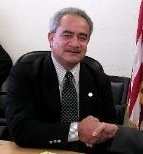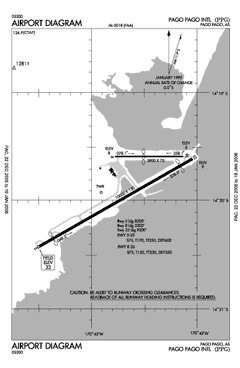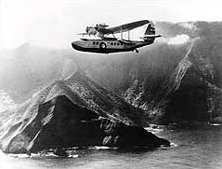Airline, Island Government Disagree
 In this corner, the
Samoan: Governor Togiola Tulafono of American Samoa. In that
corner, the Hawaiian: Hawaiian Airlines, the inter-island carrier
that also flies to the mainland and Samoa. The issue: Hawaiian's
service to the island's Pago Pago International.
In this corner, the
Samoan: Governor Togiola Tulafono of American Samoa. In that
corner, the Hawaiian: Hawaiian Airlines, the inter-island carrier
that also flies to the mainland and Samoa. The issue: Hawaiian's
service to the island's Pago Pago International.
On May 19, Tulafono sent a letter to Hawaiian's President and
CEO Mark B. Dunkerly, slamming the airline and setting out a list
of demands. If his demands were not met within a 45-day deadline,
Togiola would initiate a class-action suit against the line.
Tulafono's demands included a cut in fares to $500 round-trip,
the airline to absorb all "international" fees and charges,
eliminate excess baggage charges, provide free inflight
entertainment, make the tickets refundable and provide
Samoan-speaking gate agents and flight attendants.
The governor, called Governor Togiola on the island, complains
that poor Samoans are being gouged by Hawaiian, and hinted that
discrimination is the root of the problem (and would certainly be
charged prominently in any lawsuit). Median income on the island is
only about $10,000 a year, making a plane ticket an extreme expense
for most islanders.
 Governor Tulafono
(right) first called on Hawaiian to cut fares to $500 in February.
At the time, he said that Hawaiian was charging $763 and $1,000 for
a round-trip, and he asked the airline to drop the fares to $500 --
which he said was the average cost of a flight from Honolulu to
California, about the same distance. In his May 19th letter, he
repeated his message, charging that fees to PPG were double
Hawaiian's fees to the mainland, and calling for a cut -- only this
time he wasn't asking, he was telling.
Governor Tulafono
(right) first called on Hawaiian to cut fares to $500 in February.
At the time, he said that Hawaiian was charging $763 and $1,000 for
a round-trip, and he asked the airline to drop the fares to $500 --
which he said was the average cost of a flight from Honolulu to
California, about the same distance. In his May 19th letter, he
repeated his message, charging that fees to PPG were double
Hawaiian's fees to the mainland, and calling for a cut -- only this
time he wasn't asking, he was telling.
This week, Hawaiian honcho Dunkerly replied to Tulafono,
promising that Hawaiian had no tolerance for discrimination and any
such would be dealt with "in the most uncompromising way." But he
also gently told the governor that many of the charges in
Tulafono's letter simply weren't accurate.
"I can understand how you might feel about Hawaiian's service to
American Samoa based on the information you relayed in your letter
to me, which I suspect you had received from others. Unfortunately,
much of that information is incorrect."
Specific points that Dunkerly disputed included Hawaiian's use
of Samoan-speakers at check-in counters and on Pago Pago flights,
and the degree of control the airline has over what is an
"international" destination. That decision, he wrote, is made by
the Federal government, and it triggers a number of fees to the
disadvantage of Samoans. "There are a range of extra costs that
arise because of this designation by the U.S. government, the
clearest of which is the charge per-passenger-carried for Customs
and Immigration."
But most importantly, Dunkerly denied the charge of
discrimination, or that fares to PPG were out of proportion.
"Hawaiian uses exactly the same approach" for fares to PPG or to
mainland destinations, he said. "In each case, the cheapest fares
are non-refundable -- in fact Pago Pago was the last route on which
we applied these restrictions -- while our full fare tickets,
including those to Pago Pago are fully refundable."

The charge fees, excess baggage fees, cancellation penalties,
entertainment-system charges and no-show penalties that Governor
Tulafono thought were unique to the Honolulu-Pago Pago route also
apply identically on Hawaiian's flights to the mainland.
And fares? "Today, our lowest round-trip fare for summer travel
to Pago Pago is $674. Our lowest fare to Los Angeles is $576, and
the average of our lowest fares to all other U.S. mainland
destinations is $635. We currently have no published fares of $500
or less for travel to any of our mainland or international
routes."
 The Pago Pago fares
aren't double the mainland fares, then. But they are higher.
Dunkerly attributes this to a difference in costs. "If you look at
landing fees only, in Pago Pago we pay $1,428; in Los Angeles $908;
and just $760 on average to land at the other airports we serve on
the mainland," he says. On average, landing and other fees are
about 35% higher in Pago Pago. The differential on fuel is not that
great, but it's still there: "[O]ver the past five months the
actual difference between the LAX base fuel price and the PPG base
fuel price has averaged 34.4 cents per gallon."
The Pago Pago fares
aren't double the mainland fares, then. But they are higher.
Dunkerly attributes this to a difference in costs. "If you look at
landing fees only, in Pago Pago we pay $1,428; in Los Angeles $908;
and just $760 on average to land at the other airports we serve on
the mainland," he says. On average, landing and other fees are
about 35% higher in Pago Pago. The differential on fuel is not that
great, but it's still there: "[O]ver the past five months the
actual difference between the LAX base fuel price and the PPG base
fuel price has averaged 34.4 cents per gallon."
Dunkerly had several other issues with the information behind
the governor's letter, but closed on a positive suggestion, asking
for a face-to-face meeting, perhaps on June 26th in Samoa, or in
Honolulu at Tulafono's convenience.
This is just the latest in a string of complications for
Hawaiian Airlines. The firm has had a rocky path through Chapter
11, pulled this way and that by several trustees and literally
hundreds of lawyers filing literally thousands of motions. It
entered Chapter 11 on March 21, 2003, and has yet to emerge.
The airline flies Boeing equipment; 717-200s, which replaced
DC-9s, for inter-island flights, and 767-300ERs for longer flights,
including the Honolulu-Pago Pago run. The airline's fleet of leased
planes is only five years old on average. The airline has operated
as Hawaiian Airlines since it phased out Sikorsky flying boats in
1941, but before that it was Inter-Island Airlines from 1929. It is
the oldest US airline to have never suffered a fatal accident.

Hawaiian is the only game in town for Samoans looking to get to
or from Honolulu, Aloha Airlines having discontinued its own
twice-weekly service to Pago Pago in January, 2005. "The airline
did its best to be responsive to island communities in the remote
Pacific region but can no longer use valuable assets with a
consistently negative return," Aloha CEO David Banmiller said in
2004 of the decision to cancel Samoa (and Marshall Islands)
service.
Several airlines fly between PPG and other Pacific Rim
destinations.
 ANN's Daily Aero-Linx (04.13.24)
ANN's Daily Aero-Linx (04.13.24) ANN's Daily Aero-Term (04.13.24): Beyond Visual Line Of Sight (BVLOS)
ANN's Daily Aero-Term (04.13.24): Beyond Visual Line Of Sight (BVLOS) Airborne 04.09.24: SnF24!, Piper-DeltaHawk!, Fisher Update, Junkers
Airborne 04.09.24: SnF24!, Piper-DeltaHawk!, Fisher Update, Junkers Aero-News: Quote of the Day (04.14.24)
Aero-News: Quote of the Day (04.14.24) ANN's Daily Aero-Term (04.14.24): Maximum Authorized Altitude
ANN's Daily Aero-Term (04.14.24): Maximum Authorized Altitude







